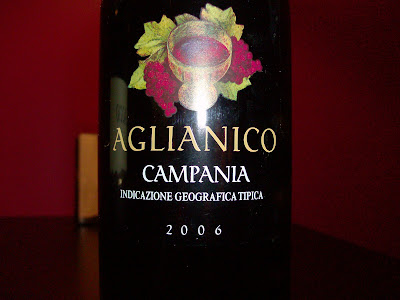Here is the LCBO information on both wines -
RIVERA CAPPELLACCIO AGLIANICO RISERVA 2004
Stock Number – 984120
750 mL bottle
Volume - 750mL
Price: $ 17.95 (+$.20 Deposit)
Wine, Red Wine,
12.0% Alcohol/Vol.
Sugar Content : XD
Made in: Puglia, Italy
By: Azienda Vinicola Rivera Spa
Release Date: May 2, 2009
Tasting Note - The more traditionally styled Cappellaccio, a monovarietal Aglianico, has fruit conserve aromas and a soft, open palate. Score - 2 Glasses (out of 3). (Gambero Rosso Italian Wines, 2008)

MASTROBERARDINO AGLIANICO 2006
Stock Number – 93112
750 mL bottle
Price: $ 22.95 (+$.20 Deposit)
Wine, Red Wine,
12.5% Alcohol/Vol.
Sugar Content : XD
Made in: Campania, Italy
By: Mastroberadino
Release Date: Feb 14, 2009
Tasting Note - Thick, dark concentration sets the stage and segues to spice and oak aromas lavished over black fruit, blueberry, granite and leather. There's also a soapy, lavender-like quality in the back. The wine has thick tannins and good length with bursting fruit flavors. Score - 88. (Monica Larner, Wine Enthusiast, Oct. 2008)
 This is a blurb from Wikipedia.org -
This is a blurb from Wikipedia.org -Aglianico (grape)
Aglianico (pronounced "ah-LYAH-nee-koe") is a black grape grown in the Campania and Basilicata regions of Italy. The vine originated in Greece and was brought to Campania by Greek settlers. The name may be a corruption of Vitis hellenica, Latin for "Greek vine". Another etymology derives the name Aglianico from a corruption of Apulianicum, the Latin adjective which indicates the whole of southern Italy in the Roman age. In early Roman times, it was the principal grape of the famous Falernian wine which was the Roman equivalent of a First Growth wine today.
Wine styles
Wines produced from Aglianico tend to be full bodied with firm tannins and high acidity, making this a wine that has aging potential. The rich flavors of the wine make it appropriate for matching with rich meats such as lamb. In Campania, the grape has been blended with Cabernet Sauvignon and Merlot in the production of some Indicazione Geografica Tipica (IGT) wines.
In its youth the wine is very tannic and concentrated, with need of a few years of ageing before it can be approachable. As it ages the fruit becomes more pronounced and the tannins more balanced with the rest of the wine. The trademark colouring of the wine is a deep garnet. In well made examples of the wine, it can have chocolate and plum aromas.
Here are my tasting notes on the two wines –
RIVERA CAPPELLACCIO AGLIANICO RISERVA 2004
Deep dark brownish red colour with a powerful and aromatic nose. The three aromas I got from the wine were strawberry, soap and smoke. The wine was very dry and big bodied, I found the acidity too high compared to the tannin causing the balance on the wine to be off. We had sandwiches and cheese and crackers to go with the wine and I found that the wine was too ‘big’ to go with these. I have had this wine a few weeks ago with a rich and heavy parmesan cheese sauce and pasta and it was a nice match. This is not a wine I could see someone sitting around on the patio and drinking on its own.
MASTROBERARDINO AGLIANICO 2006
The colour depth on this wine was lighter than the first but had a similar brownish red colour. The nose wasn’t as powerful either. The aromas on this one were leather, cherry and dark berry which was very different from the nose of the first as well. Big acidity on this one but the tannin levels were about the same but with a more softer feel in the mouth. The wine seems more toned down yet more refined than the Rivera. As there were so many differences I wonder if one of them was a blend with another type of grape and one was a pure Aglianco as that could explain the large differences between them. The Mastroberardino was a nicer pairing with the sandwiches and cheese and crackers and was much more approachable on its own.
I really wasn’t enamored with either of these wines, though I could see them being interesting when paired rich and heavy food dish that could stand up to them.
Cheers!
Mark

No comments:
Post a Comment